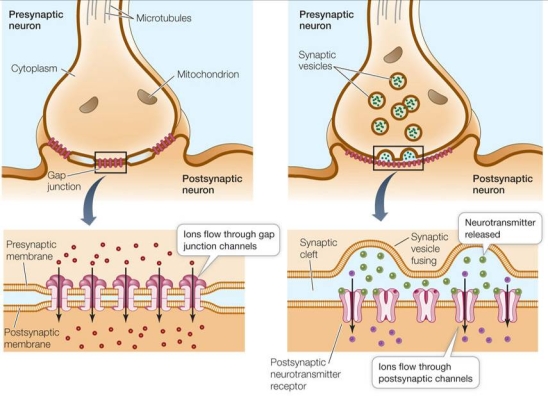Refer to the figure below.  It has been hypothesized that during development of the mammalian brain, neurons are first coupled through gap junctions to one another during the first few days after birth.These gap junctions provide a conduit for propagation of electrical activity as a flow of ions between neurons, as depicted in the figure on the left.However, it is thought that these gap junctions are replaced after this initial period with a chemical signaling system, as depicted in the figure on the right.This system involves one neuron secreting neurotransmitter compounds that carry the signal across the extracellular space to an adjacent neuron, where the electrical signal is continued.Design an experiment to test the hypothesis that gap junctions are replaced during the early days after birth.You may use rats and the compound halothane in your design.Halothane is a compound known to specifically bind to and block gap junctions.
It has been hypothesized that during development of the mammalian brain, neurons are first coupled through gap junctions to one another during the first few days after birth.These gap junctions provide a conduit for propagation of electrical activity as a flow of ions between neurons, as depicted in the figure on the left.However, it is thought that these gap junctions are replaced after this initial period with a chemical signaling system, as depicted in the figure on the right.This system involves one neuron secreting neurotransmitter compounds that carry the signal across the extracellular space to an adjacent neuron, where the electrical signal is continued.Design an experiment to test the hypothesis that gap junctions are replaced during the early days after birth.You may use rats and the compound halothane in your design.Halothane is a compound known to specifically bind to and block gap junctions.
Definitions:
Parasympathetic Nervous System
Part of the autonomic nervous system that helps the body conserve energy and promotes relaxation and digestion.
Somatic Nervous System
A component of the peripheral nervous system that controls voluntary movements of the body's muscles.
Central Nervous System
The part of the nervous system consisting of the brain and spinal cord, which integrates information received from the body and coordinates activity.
Norepinephrine
A neurotransmitter and hormone involved in the body's fight or flight response, influencing attention, heart rate, and blood pressure.
Q41: The oxidation of acetyl CoA to CO<sub>2</sub>
Q63: Refer to the figure below showing a
Q86: In solution, ATP is readily hydrolyzed into<br>A)
Q86: The diagram below shows the interface between
Q134: Specialized cells in the heart are able
Q194: Refer to the figure below. <img src="https://d2lvgg3v3hfg70.cloudfront.net/TB5650/.jpg"
Q197: To visualize subcellular structures such as chloroplasts,
Q224: In some biological membranes the lipid bilayer
Q225: Which statement about channel proteins is true?<br>A)
Q228: How do competitive and noncompetitive enzyme inhibitors